
NGC 4485, 11m7, 2.3' x 1.6', IB(s)m pec
NGC 4490, 9m5, 6.4' x 3.1', SB(s)d pec
Distance: approx. 40 MLy
Canes Venatici
Uranometria: S. 75 (old), S. 37-right (new)
DSS II (7' x 7')
further information:
SDSS Image
Messier45.com

Martin Schoenball 10", 100x, fst 6m3
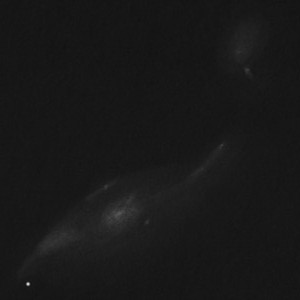
Uwe Glahn, 16", 360x, fst 6m8:
spectacular galaxy pair; NGC 4490 as 1:3 NW - SE elongated galaxy with bright and turned core; to the NW and SE two bright spiral arms; SE arm with a brighter region in the middle; NW arm with two brighter regions; bright longish HII region next to the core to NE; one more HII region SW of the core; companion NGC 4485 1:2 N - E elongated with bright HII region to the SW
Uwe Glahn, 4", 63x, fst 6m5+:
NGC 4485: Is faint but definitely visible at 63x, elongated 2:1 NE-SE, no
brightening towards the middle.
NGC 4490: Is prominent even at 18x
magnification, elongated 2:3 SE-NE, little concentrated.
Matthias Juchert, 8", fst 6m3:
NGC 4485: Twisted
by 90° this edge-on galaxy lies close to NGC 4490. I cannot see the connection
of the galaxies. The galaxy appears pretty large, oblong, smaller than NGC 4490
and stands out well with averted vision.
NGC 4490: Very bright galaxy, pretty close to Beta Canum Venaticorum. Pretty
extended and elongated 3:1. The companion is close.

NGC 3395, 11m8, 2.1' x 1.2', SAB(rs)cd pec
NGC 3396, 12m0, 3.1' x 1.2', IBm pec
Enfernung: approx. 80 MLy
Leo Minor
Uranometria: S. 105 (old), S. 55-left (new)
DSS II (5' x 5')
further information:
SDSS Image
Messier45.com
Martin Schoenball, 10", 150x, fst 6m1:
NGC 3395: Faint galaxy, elongated about 3:1 SE-NE, brighter one, very faint stellar core. Pretty much the same as NGC 3396 but SW-NO elongated. Brighter than ist neighbor with a faint, stellar core.
NGC 3396: Pretty much the same as its neighbor but elongated NW-SE und little fainter, slightly brighter center, touches NGC 3395 at a 90 degree angle
Matthias Juchert, 8", fst 6m5:
NGC 3395 is only a little brighter and larger than its neighbor. It appears as an oval to slightly oblong nebula in N-S direction. There are no traces of the southern spiral arm, but the galaxy has a prominent core.
NGC 3396: Little fainter but visible with direct vision at 126x. About 1/4 smaller than its neighbor and with an obvious core. Elongated E-W. Very nice!

NGC 5426, 12m1, 3.0' x 1.6', SAB(rs)bc pec
NGC 5427, 11m4, 2.8' x 2.4', SA(s)c pec II
Distance: approx. 120 MLy
Virgo
Uranometria: S. 286 (old), S. 129-right (new)
DSS II (5' x 5')
further information:
Messier45.com
not observed yet

UGC 1810, 13m9, 2.2' x 1.5', S(b)
UGC 1813, 14m5, 1.5' x 0.4', SB
Distance: approx. 350 MLy
Andromeda
Uranometria: S. 62 (old), S. 61-right (new)
DSS II (5' x 5')
further information:
Messier45.com
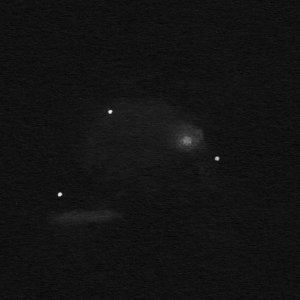
Uwe Glahn, 16", fst 7m2:
very faint hints of spiral structure, 1:3 elongated faint companion

NGC 4809, 14m0, 1.8' x 0.9', Im pec
NGC 4810, 14m3, 1.9' x 0.8', Im pec
Distance: approx. 40 MLy
Virgo
Uranometria: S. 239 (old), S. 110-right (new)
DSS II (5' x 5')
further information:
SDSS Image
Messier45.com
Matthias Juchert, 8", fst 6m7:
NGC 4809 and NGC 4810 form a very close, faint pair of galaxies. I could not split the pair at 126x due to their faintness. They appeared as one oval, slightly irregular nebula, elongated in NW-SE direction.

NGC 7253A, 13m7, 1.7' x 0.5', SB?
NGC 7253B, 14m3, 1.6x0.5', S?
Distance: approx. 210 MLy
Pegasus
Uranometria: S. 122 (old), S. 46-right/64-right (new)
DSS II (5' x 5')
further information:
Messier45.com

Uwe Glahn, 16", fst 7m0:
brighter NGC 7253A easy to detect, 1:4 elongated, faint double star on its western end, 7253B much more fainter, short, starts at the faint double star

NGC 3769, 11m5, 3.1' x 1.0', SB(r)b:
NGC 3769A, 14m2, 1.1' x 0.5', SBm pec III
Distance: approx. 35 MLy
Ursa Major
Uranometria: S. 74 (old), S. 38-left (new)
DSS II (5' x 5')
further information:
SDSS Image
Messier45.com
Uwe Glahn, 16", 225x, fst 6m9:
NGC 3769 1:3 SE-NW elongated without structure; at ist SE end NGC 3769A started at the E side; NGC 3769A 1:3 E-W elongated, faint spot

NGC 4627, 12m0, 2.6' x 1.8', E4 pec
NGC 4631, 9m0, 15.5' x 2.7', SB(s)d III
Distance: approx. 30 MLy
Canes Venatici
Uranometria: S. 108 (old), S. 53-right/54-left (new)
DSS II (15' x 15')
further information:
SDSS Image
Messier45.com
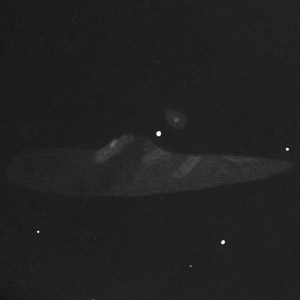
Martin Schoenball, 10", 100x, fst 6m2:
NGC 4627: pretty faint, slightly elongated N-S, central brightening, when using averted vision a faint stellar nucleus is visible.
NGC 4631: very bright, very large galaxy, elongated about 7:1 SW-NE, irregular brightness distribution, several bright smudge along the western edge. West of the center is a faint star. In field with NGC 4627.
Matthias Juchert, 8", fst 5m5:
NGC 4631 is a wonderful galaxy. Very bright, large, elongated and structured all over. Its appearance reminds to M 82. The small companion NGC 4627 is clearly visible but not that spectacular as NGC 4631.

NGC 169, 12m4, 2.7' x 0.7', SA(s)ab: sp
IC 1559, 14m0, 0.8' x 0.5', SAB pec:
Distance: approx. 210 MLy
Andromeda
Uranometria: S. 126 (old), S. 63-left/80-right (new)
DSS II (5' x 5')
further information:
Messier45.com
not observed yet

NGC 2798, 12m0, 2.6' x 1.0', SB(s)a pec
NGC 2799, 13m7, 1.9' x 0.5', SB(s)m?
Distance: approx. 80 MLy
Lynx
Uranometria: S. 71 (old), S. 39-right (new)
DSS II (5' x 5')
further information:
SDSS Image
Messier45.com
Uwe Glahn, 20", 360x, fst 6m5:
NGC 2798 bright, elongated 1:3 N-S, bright, round core, diffus borders, NGC 2799 bean shape with concave side to the NE, galaxy elonated 1:4 SE-NW

NGC 7714, 12m2, 1.9' x 1.4', SB:(s)b? pec
NGC 7715 ,14m1, 2.6' x 0.5', Sa? pec sp
Distance: approx. 130 MLy
Pisces
Uranometria: S. 259 (old), S. 101-right (new)
DSS II (5' x 5')
further information:
Messier45.com

Uwe Glahn, 16", 360x, fst 6m7:
pair only 4' north of the bright star 16 Psc (5.7mag), NGC 7714 much more brighter than NGC 7714, offset nucleus to the NW, eastern side diffuse, NGC 7714 extreme edge-on character, faint elongated nucleus, western end bent to the north
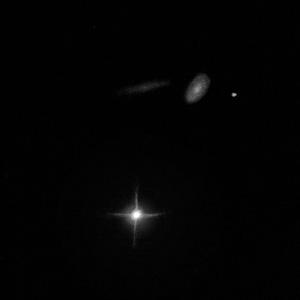
Matthias Juchert, 12,5", fst 7m0:
NGC 7714 is already visible at 47,5x as a small, round nebula. The center is very small and clearly divided. No dark structure discernible. The bright star in the field of view doesn't impair perception.
NGC 7715: A quite difficult object - even with 12,5 inch! With averted vision a faint, extended streak of nebulosity is visible at 30-40% of time at 169x elongated in direction of NGC 7714. Little brighter center. The galaxies do not seem to be connected visually.

NGC 5560, 12m4, 3.7' x 0.7', SB(s)b pec
NGC 5566, 10m7, 6.6' x 2.2', SB(r)ab
NGC 5569, 13m7, 1.7' x 1.5', SAB(rs)cd
Distance: approx. 75 MLy
Virgo
Uranometria: S. 242 (old), S. 109-right (new)
DSS II (10' x 10')
further information:
SDSS Image
Messier45.com
Matthias Juchert, 12,5", fst 6m5:
NC 5560: Faint but with averted vision visible with certainty. Long nebula with bright center. Too thick to be in exact edge-on orientation.
NGC 5566: Easy visible with direct vision at 50x as a moderately small nebula. At 126x the nebula does not appear exactly round but with slight irregularities in north and south directions, that look like spider legs. The core is very bright - the faint arms, visible on the DSS image are not detectable with 8".
NGC 5569: Very faint und only visible with averted vision. Small, round nebula with a very faint central brightening at 126x.

IC 195, 13m1, 1.6' x 0.8', S0
IC 196, 13m0, 2.8' x 1.4', S0-
Distance: approx. 160 MLy
Aries
Uranometria: S. 174 (old), S. 99-right (new)
DSS II (5' x 5')
further information:
SDSS Image
Messier45.com
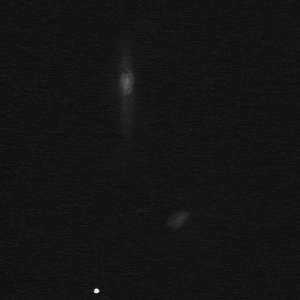
Uwe Glahn, 20", 434x, fst 6m5:
brighter IC 196 elongated 1:5, bright 1:2 elongated nucleus, fainter streams of light to the north and south, south side little longer, no bend to IC 195, IC 195 with bright surface brightness, elongated, lies only 2' SW

PGC 72139, 13m7, 1.9' x 0.3', Sc
PGC 72155, 14m0, 0.9' x 0.5', ? Sb pec
Distance: approx. 310 MLy
Pisces
Uranometria: S. 259 (old), S. 101-right (new)
DSS II (10' x 10')
further information:
Messier45.com
not observed yet

IC 694, 15m0, 0.3' x 0.2'
NGC 3690A, 11m2, 2.1' x 1.6', IBm pec
NGC 3690B, 10m9, 1.2' x 1.0', SBm? pec
Distance: approx. 140 MLy
Ursa Major
Uranometria: S. 46 (old), S. 24-right (new)
DSS II (5' x 5')
further information:
SDSS Image
Messier45.com
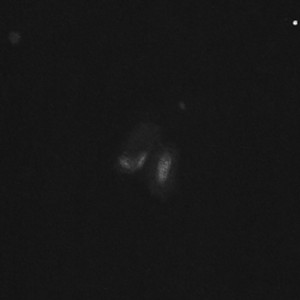
Uwe Glahn, 16", 360x, fst 6m8:
small, very compact galaxy group; consists of two parts; brighter part at the W is 1:2 N-S elongated; fainter part at the E is structured; galaxy IC 694 only 1' NW, PGC 35345 only 2,5' NE
Martin Schoenball, 10", 221x, fst 5m2:
NGC 3690A together with NGC 3690B visible as one nebula, bright but pretty small. A star lies in the SW within the nebula. The nebula gets broader but fainter towards north and is N-S elongeted (NGC 3690A). The western part (NGC 3690B) is round. Between them is a dark structure. A bright star lies towards S.
Matthias Juchert, 8", fst 6m4:
The double system of NGC 3690A and NGC 3690B appears as an obvious nebula even at 50x. Only 3' due to south lies a 11m3 star making a good contrast. The two interacting galaxies appear as one object even at very high magnifications. They form a moderately small, round-oval nebula with a very bright center. In the literature one often can find IC 694 as one of the two galaxies. But actually it is the very small elliptical at the north-west border of NGC 3690. But this one is too faint to be seen with 8".

NGC 1241, 12m2, 2.8' x 1.7', SAB(rs)bc II
NGC 1242, 13m7, 1.2' x 0.7', SB:(s:)cd III
Distance: approx. 180 MLy
Eridanus
Uranometria: S. 266 (old), S. 138-right (new)
DSS II (5' x 5')
further information:
Messier45.com
not observed yet

NGC 2872, 11m9, 2.1' x 1.8', E2
NGC 2874, 12m6, 2.4' x 0.7', SB(r)bc
Distance: approx. ~ 150 MLy
Leo
Uranometria: S. 188 (old), S. 93-right (new)
DSS II (5' x 5')
further information:
SDSS Image
Messier45.com
Uwe Glahn, 16", 300x, fst 6m5:
NGC 2872 bright, round, structureless glow, NGC 2874 1:3 NE-SW elongated, mottling core, small, faint part at the NE (NGC 2875), NGC 2873 2' NE

NGC 545, 12m3, 2.4' x 1.6', E+3
NGC 547, 12m3, 1.3' x 1.3', E1
Distance: approx. 250 MLy
Cetus
Uranometria: S. 218 (old), S. 120-left/A 16 (new)
DSS II (5' x 5')
NGC 545/7 are the central-galaxies of Abell 194
further information:
Messier45.com
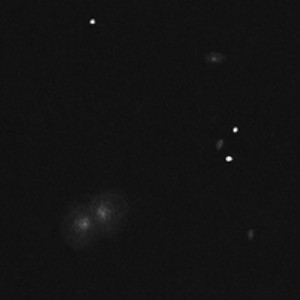
Uwe Glahn, 16", 257x, fst 6m8:
both galaxies NGC 545/547 are central part of galaxy cluster Abell 194, both galaxies have the same brightness and size, the elongated halo of NGC 545 is not visible, the halos of both galaxies are not separated
Martin Schoenball, 10", 197x, fst 7m0:
NGC 545: bright but little fainter and smaller than NGC 547, brighter towards the center and elongated E-W, in contact with NGC 547
NGC 547: bright, round, much brighter center with core, in contact with NGC 545

NGC 942, 13m0, 2.1' x 1.1', S0: pec
NGC 943, 12m9, 2.2' x 1.1', S0^0: pec
Distance: approx. 210 MLy
Cetus
Uranometria: S. 265 (old), S. 139-left (new)
DSS I (5' x 5')
further information:
Messier45.com
not observed yet

NGC 2831, 13m4, 1.4', E0
NGC 2832, 11m8, 2.4' x 1.9', E+2
Distance: approx. 350 MLy
Lynx
Uranometria: S. 103 (old), S. 56-right/A 5 (new)
DSS II (5' x 5')
NGC 2832 is central-galaxy of Abell 779
further information:
SDSS Image
Messier45.com
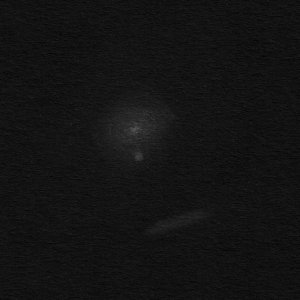
Uwe Glahn, 16", 300x, fst 6m5:
center of galaxy cluster Abell 779, NGC 2832 brightest member with round, diffus halo, NGC 2831 at the SW edge of the halo of NGC 2831, galaxy itself small, round
Matthias Juchert, 12,5", fst 6m8:
NGC 2831 is in contact with the much brighter and larger galaxy NGC 2832.
NGC 2831: It shows up as a faint, small nebula with a bright center.
NGC 2832: Brightest galaxy of Abell 779. Pretty bright and easy. A large round-oval nebula with a bright, extended center. NGC 2831 lies due west.

NGC 3187, 12m9, 3.0' x 1.3', SB(s)c pec
NGC 3189, 12m1p, 4.4' x 1.6', Sa
NGC 3193, 10m8, 3.0' x 2.7', E2
Distance: approx. 60 MLy
Leo
Uranometria: S. 144 (old), S. 73-right (new)
DSS II (10' x 10')
further information:
Messier45.com
Uwe Glahn, 4", 54x, fst 6m5:
With 4" the 3 brightest members of
this brightest Hickson group are visible
NGC 3189/3190: HCG 44a, prominent, elongated 2:1 SE-NW.
NGC 3193: HCG 44b is an easy round smudge
NGC 3185: HCG 44c is a very faint smudge
Uwe Glahn, 16":
Easiest hickson-galaxy group,
all 4 members easy to see, no definite visual detection of the spiral structure
of NGC 3187, dust lane of NGC 3190 not easy but detectable.
Matthias Juchert, 8", fst 6m2:
NGC 3189: This NGC entry is meant to be the southwestern part of NGC 3190 which has been seen as a single object by earlier observers. At 98x the dust lane of the galaxy appears only very faint, and the separation is not really comprehensible.
NGC 3190: at 126x brightest object of this Hickson group. Bright oblong-oval galaxy. Very bright center. The dust lane is visible from west to slightly south of the core with averted vision at 98x, difficult detail!
NGC 3193: Pretty small, bright, round nebula close to a bright, disturbing 9m6 star. But still easily visible.

Leo Triplett
Messier 65, 9m2, 9.9' x 2.9', SAB(rs)a II
Messier 66, 8m9, 9.1' x 4.2', SAB(s)b II
NGC 3628, 9m6, 14.8' x 3.0', Sb pec sp II
Distance: approx. 35 MLy
Leo
Uranometria: S. 191 (old), S. 91-right/92-left (new)
DSS I (60' x 60')
further information:
SDSS Image (M 65)
SDSS Image (M 66)
SDSS Image (NGC 3628)
Messier45.com

Uwe Glahn, 20x125, fst 6m5:
famous and easy triple system even in the bino

Martin Schoenball, 10",139x, fst 6m3:
M 65: Large, long eliipse. Elongation about 6:1. Bright round center which streches over the full width of the galaxy. Out of the center the galaxy is of even brightness, no details
M 66: see Arp 16
NGC 3628: Large, faint, very long, no prominent core but a long brightening in the center

NGC 833, 12m8, 1.5' x 0.7', AB(rs)c
NGC 835, 12m2, 1.3' x 1.1', SAB(r)ab:pec
NGC 838, 13m0, 1.2' x 0.9', SA?(rs)0^0:
NGC 839, 13m1, 1.5' x 0.7', I0? pec
Distance: approx. 180 MLy
Cetus
Uranometria: S. 264 (old), S. 139-right (new)
DSS II (5' x 5')
further information:
Messier45.com

Uwe Glahn, 16", 257x, fst 6m8:
Hickson 16 is an easy group for a 16", NGC 833 and 835 are the brightest galaxies, NGC 833 is 1:3 E-W elongated with elongated nucleus, NGC 835 also shows a brighter nucleus, NGC 839 is also 1:3 E-W elongated without a brighter nucleus

Stephan's Quintet
NGC 7317, 13m6, 1.1' x 1.1', ? E4
NGC 7318A, 13m4, 0.9', E2 pec
NGC 7318B, 13m2, 1.9' x 1.2', E2
NGC 7319, 13m3, 1.7' x 1.3', SB(s)bc pec
NGC 7320, 12m5, 2.2' x 1.1', SA(s)d
Distance: approx. 300 MLy, NGC 7320 approx. 35 MLy
Pegasus
Uranometria: S. 123 (old), S. 46-right (new)
DSS II (5' x 5')
further information:
Messier45.com
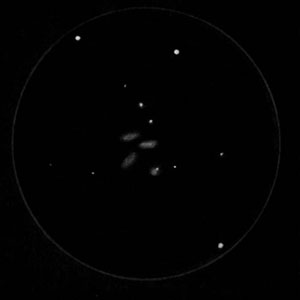
Matthias Juchert, 8", fst 6m9:
NGC 7317: Very faint and very small. The bright adjoining star disturbs the perception. Only blinkingly visible with averted vision as tiny, round smudge.
NGC 7318A/B: Most prominent object of the group. Obvious with averted vision but still faint. Elongated 2:1 E-W. Both objects can not be splitted. 126x
NGC 7319: Very faint with averted vision. Elongated with faint center. 126x
NGC 7320: Very faint only with averted vision. Orientation at PA 330°. Largest of the group. Difficult due to low surface brightness. 126x
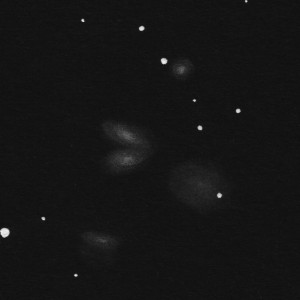
Uwe Glahn, 16", 189x, fst 6m3: (Drawing with 16", 257x, fst 7m4)
famous "Stephan's Quintet", not easy
but all 6 galaxies detectable, NGC 7319 and NGC 7320 brightest members, NGC 7318A+B difficult to separate visually, NGC 7320C most difficult galaxy, very faint glow

Copeland's Septet
NGC 3745, 15m2, 0.4' x 0.2', SB(s)0-:
NGC 3746, 14m0, 1.1' x 0.5', SB(r)b
NGC 3748, 14m8, 0.7' x 0.4', SB0^0^? sp
NGC 3750, 13m9, 0.8' x 0.7', SAB0-? sp
NGC 3751, 13m9, 0.8' x 0.5', S0- pec?
NGC 3753, 13m7, 1.7' x 0.5', Sab? pec SB
NGC 3754, 14m3, 0.4' x 0.3', SBc
Distance: approx. 420 MLy
Leo
Uranometria: S. 147 (old), S. 72-right (new)
DSS II (5' x 5')
further information:
Messier45.com
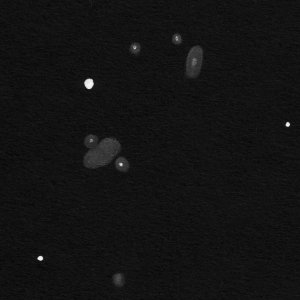
Uwe Glahn, 16", 257x, fst 6m3:
very beautiful septet, all 7 galaxies detectable with 16", NGC 3750, 3751, 3753 bright and easy, separation of NGC 3753 and 3754 difficult to see, only with averted vision, NGC 3746 elongated, NGC 3745, 3748 small, round
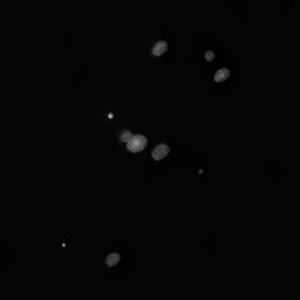
Matthias Juchert, 12,5", fst 7m0:
NGC 3745: Very difficult! This small nebula lies between the much easier galaxies NGC 3746 and NGC 3748 and much closer to NGC 3746. Only visible with averted vision as a diffuse object with an illdefined shape.
NGC 3746: Pretty faint and just detectable with direct vision. Little brighter center in an oval halo at 225x.
NGC 3748: Visually very similar to NGC 3746. Pretty faint and not steadily visible with direct vision. At 225x the little brighter center is visible but the halo appears roundish.
NGC 3750: At 225 appears a pretty faint, round-diffuse object in the FOV. This galaxy forms the central galaxy of Copelands Septet together with NGC 3753 and NGC 3754.
NGC 3751: The southernmost galaxy of Copelands Septet. At 225x faint but clearly visible, round galaxy with slightly brighter center with averted vision.
NGC 3753: The brightest galaxy in Copelands Septet. Pretty bright and visible with direct vision at 225x. The galaxy appears oval with a bright, nearly stellar core.
NGC 3754: With no doubt the toughest galaxy of Copelands Septet together with NGC 3745. It is so difficult due to the small distance to NGC 3753 with which it merges at low magnification. The small round companion is just splitted at 225x.
Martin Schoenball, 10", 179x, fst 6m6:
NGC 3745: Very unsure, from time to time something showed up, but more likely not seen.
NGC 3746: Visible well but difficult
NGC 3748: Very unsure, from time to time something showed up, but more likely not seen.
NGC 3751: Only suspected, very difficult because the are no star that can help as reference point.
NGC 3753: Brightest galaxy of Copelands Septett, blurred together with N 3750 and N 3754. Pretty easy, but extend is hard to see.

Hickson 56
PGC 35609, 15m6, 0.3' x 0.2', SB0 pec
PGC 35615, 15m9, 0.2' x 0.1', S0
PGC 35618, 15m8b, 0.3' x 0.2', S0
PGC 35620, 15m0b, 0.5' x 0.3', S0-a
PGC 35631, 16m1b, 0.7' x 0.1', Sc
Distance: approx. 380 MLy
Ursa Major
Uranometria: S. 47 (old), S. 24-right (new)
DSS II (5' x 5')
further information:
SDSS Image
Messier45.com

Martin Schoenball, 10", 197x, fst 6m8:
PGC 35620 (middle): faint galaxy, round, a very faint stellar core blinks (Seyfert I Gx!), brightest member of HCG 56.
PGC 35618 (bottom): very faint galaxy, round, no details, 2nd brightest member of HCG 56.
PGC 35631 (left): extremely faint, elongated N-S, no detail, 3rd brightest member of HCG 56.

Uwe Glahn, 16", 320x, fst 6m5:
HCG 56b brightest member of the Hickson group, E-W elongated, HCG 56c 30" W of HCG 56b, also elongated wisp of light, HCG 56d not to see, HCG 56e hard to detect, stellar galaxy, HCG 56a 1:3 N-S elongated 1,2' SE of HCG 56b, small surface brightness

PGC 35572, 16m7b, E pec
PGC 35573, 17m0b, SBa pec:
PGC 35575, 15m8b, SA0 pec
PGC 35576, 17m4b, s?
PGC 35574, 17m3b, S0pec
Distance: approx. 700 MLy, PGC 35576 approx. 1,7 MLy
Draco
Uranometria: S. 25 (old), S. 13-right (new)
DSS II (5' x 5')
further information:
Messier45.com
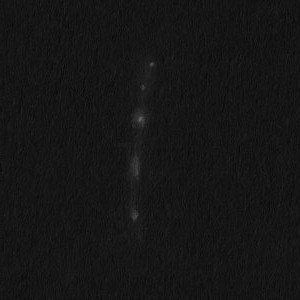
Uwe Glahn, 24", 390x, fst 6m7:
famous but difficult Hickson 55-group, only 1' long chain of 5 faint galaxies, 55a brightest member, round, 55b more difficult, but easy to detect, 55c N-S elongated faint spot, 55d difficult stellar point at the N end of the chain, between 55d and 55a most difficult member 55d, very difficult, faint even glow, stellar

Pisces Chain
NGC 379, 12m9, 1.4' x 0.8', S0
NGC 380, 12m6, 1.4' x 1.2', E2
NGC 382, 13m2, 0.7', E0
NGC 383, 12m2, 1.6' x 1.4', SA0-
NGC 384, 13m0, 1.1' x 0.9', E3
NGC 385, 13m0, 1.1' x 1.0', LA-*
NGC 386, 14m5, 0.9' x 0.8', E3
NGC 388, 14m6, 0.9' x 0.8', E3
Distance: approx. 230 MLy
Pisces
Uranometria: S. 91 (old), S. 62-right/A 7 (new)
DSS II (15' x 15')
further information:
Messier45.com
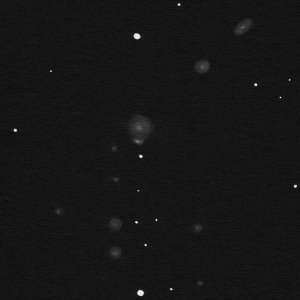
Uwe Glahn, 16", 189x, fst 6m9:
one of the most beautiful galaxy chains in the sky, famous Pisces Chain, 11 galaxies detectable, NGC 383 bright, big, round, NGC 382 separated from NGC 383, NGC 380 north, bright, round, NGC 379 northernmost galaxy, elongated, NGC 385 south, big, bright, NGC 384 only round, no elongation, NGC 386 small, faint, NGC 387, 375, 373, 388 small, faint galaxies
Martin Schoenball, 10", 197x, fst 6m5:
NGC 379: Brighter galaxy, slightly brighter towards the center, has a broad central brightening. Pretty high surface brightness. Large, perhaps the third brightest member of the Pisces Chain. Easy.
NGC 380: Pretty faint, little brighter middle, no core. Little northwest is an extremely faint star.
NGC 382: Very faint, small smudge. Lies between a 12mag star SW and very close to NGC 383 NE. Round, slightly brighter center, small.
NGC 383: By far the brightest member of the Pisces Chain. It is bright and round. Brighter to the center but shows no core. Pretty broad central brightening. Many other galaxies close!
NGC 384: Very diffuse galaxy with an extremely faint stellar core. Large but low surface brightness, round. Easy.
NGC 385: Faint galaxy, visible with direct vision. Brighter to the middle and appears to have an extremely faint core. This may be shifted east. Pretty easy.
NGC 386: Very faint brightening, very small but high surface brightness. Only visible with averted vision.
Matthias Juchert, 8", fst 6m9:
NGC 379: Northernmost galaxy of this 5 galaxy chain in the central area of the NGC 383 group. NGC 379 is a little fainter than NGC 380 2' due south but is detectable from time to time. Smaller than its neigbor and oval shape.
NGC 380: Second brightest galaxy in the central area of the NGC 383 group. Prett faint, but visible from time to time with direct vision. It appears as a round-oval nebula with brigh center at 126x.
NGC 383: By far the brightest galaxy of the group. Even visible at 50x as a small nebula little north of a star. At 126x it appears pretty large, pretty bright with a very bright core.
NGC 384: Forms a nearly identical pair with NGC 385 about 1,6' due north. Similar to the neighbor galaxy it shows up as a small round-oval nebula with a bright central area.
NGC 385: Forms a nearly identical pair with NGC 384 about 1,6' due south. The galaxy appears pretty faint and requires averted vision. It shows up as a small, round-oval nebula with brighter center.